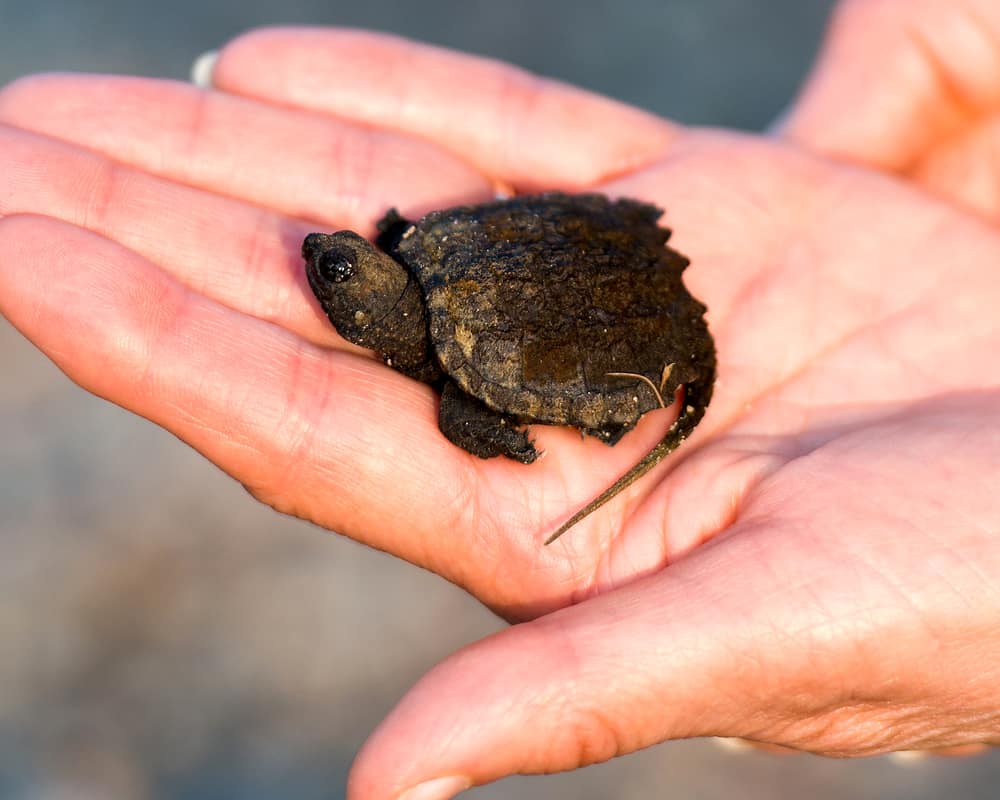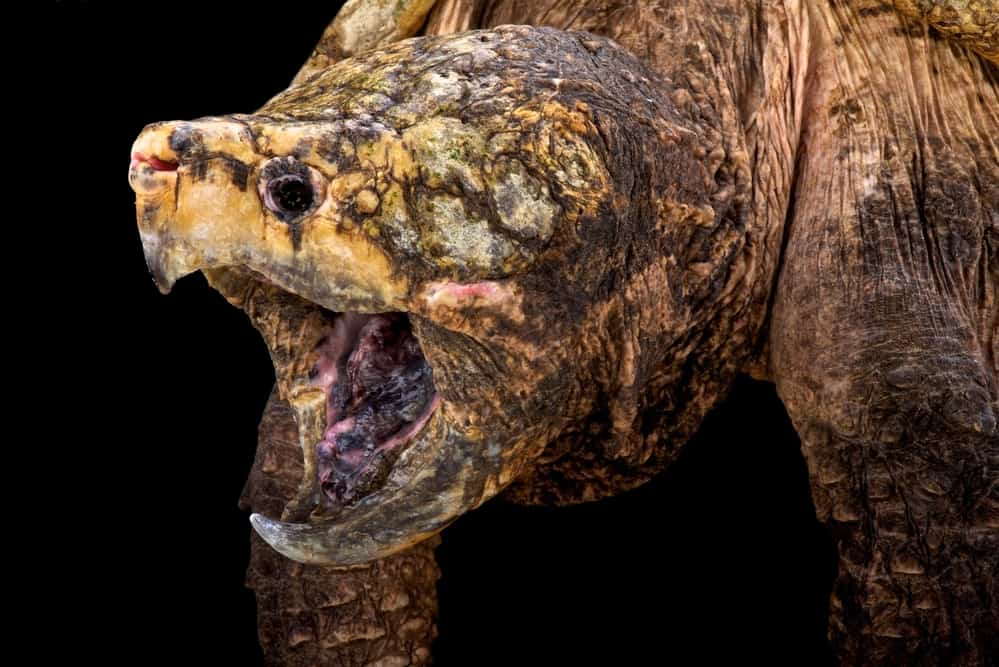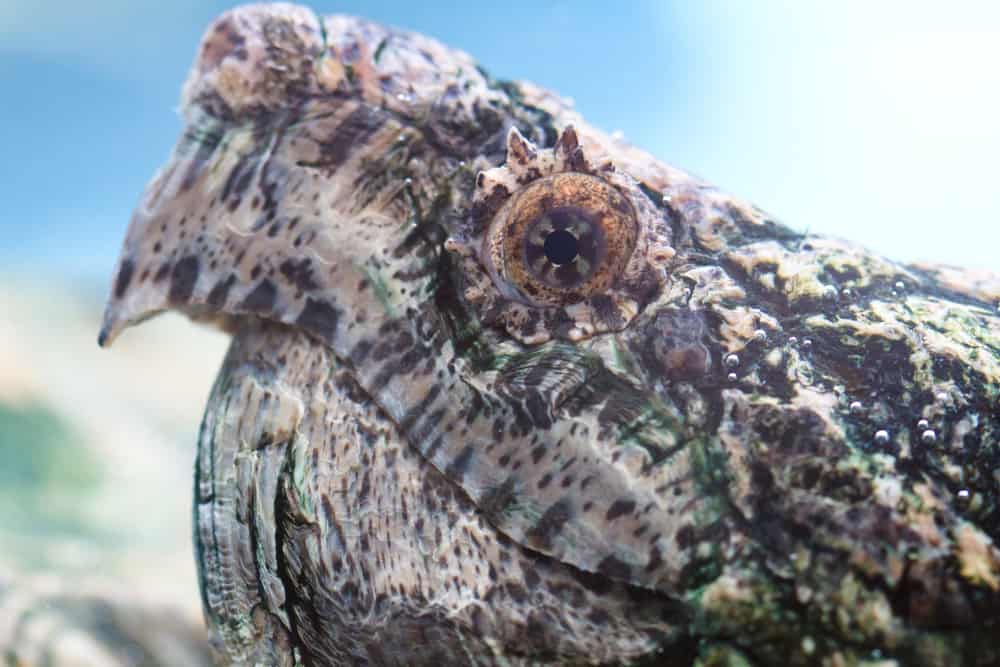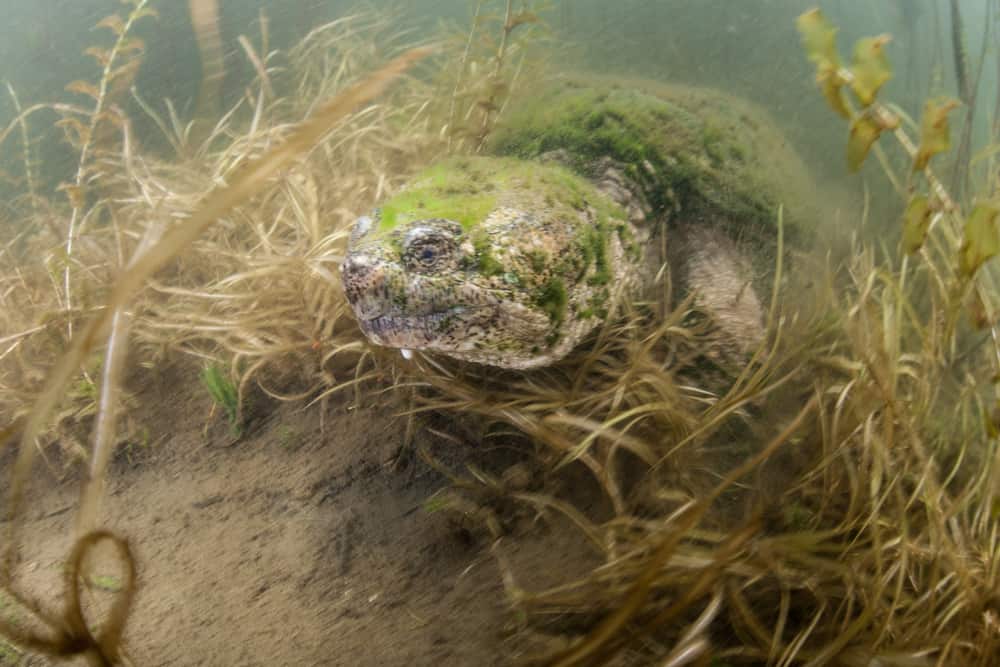Have you ever wondered what the difference is between an alligator snapping turtle (Macrochelys temminckii) and a common snapping turtle (Chelydra serpentina)?
Is there a difference?
Both species belong to the family Chelydridae, but they’re definitely not the same animal.
Let’s find out some key differences as we discuss the common snapping turtle vs alligator snapping turtle.
In This Article
Common Snapping Turtle vs Alligator Snapping Turtle
- Scientists believe both species can live for over 100 years.
- The alligator snapping turtle‘s range is limited to the southeastern United States.
- The common snapping turtle has a more extensive range covering much of eastern North America.
- Both species primarily eat meat, but the common snapping turtle also eats aquatic plants and roots.
- The common snapping turtle looks more like a “regular” turtle, with a smooth shell and rounded head.
- The alligator snapping turtle has a prehistoric appearance, with a spiny shell and rough appearance.
- Neither species makes a good pet, but the common snapping turtle is probably better suited for captivity due to its smaller size and calmer temperament.
Baby Alligator Snapping Turtle vs. Baby Common Snapping Turtle
As babies, the differences between the alligator snapping turtle and common snapping turtle are a tad harder to notice.

As common snappers mature, the dorsal ridges become smaller, and the shell smooths out. The alligator snapping turtle keeps their ridges throughout its entire life.
That’s why it’s easier to differentiate adult common snappers from adult alligator snappers.
Otherwise, babies of both species have the same physical differences as adults.
Physical Description
Once you know what to look for, it’s easy to tell these species apart based on their physical appearance.
Alligator Snapping Turtles
An alligator snapping turtle has a more prehistoric appearance overall.
They keep their spiky ridges into adulthood. Even their skin seems tougher, with more bumps and wrinkles.
Their heads are angular, taking on an almost triangular appearance from above, and their eyes are positioned on the sides of their head.
An alligator snapping turtle’s beak (mouth) is hooked at the end to help them catch live prey and tear away flesh.

When these turtles open their mouths, you can also see their bright red, fleshy tongue lures. They’re the only turtle with that type of adaptation, which they use to attract prey.

Last but certainly not least – alligator snappers are enormous. The largest turtle reportedly weighed nearly 300 pounds! They usually max out around 175 pounds with a 32-inch shell.
Common Snapping Turtles
The common snapper looks more like a ‘regular’ turtle on steroids.
Their shells become rounded and smooth, especially in old individuals.
Even after their shells smoothen out, they still have impressively long and spiky tails. Their tails are dead giveaways when comparing them to other native turtle species.

Their heads are rounded, too, and their eyes face forward.
While common snappers aren’t quite as large as alligator snappers, they’re still the largest native turtle in much of their range.
This species rarely grows larger than 18 inches long and 35 pounds.
Native Range and Habitat
Alligator and common snapping turtles live in the same types of habitat in the wild. They’re freshwater species that will occasionally visit brackish waters.
Otherwise, they prefer habitats with dense aquatic vegetation, slow-moving water, and muddy bottoms.
Their ranges overlap in alligator snapping turtle territory, but the primary difference between the species is their native ranges.
Alligator Snapping Turtles
- Southeastern United States
- As far North as central Illinois
- As far South as northern Florida
- As far West as eastern Texas
- As far East as the Georgia Atlantic coast
Common Snapping Turtles
- North America
- As far North as Manitoba, Canada
- As far South as Florida
- As far West as New Mexico
- As far East as Nova Scotia, Canada
Most people are more likely to come across a common snapper than an alligator snapper. That’s because their populations are thriving, and their range is extensive.
Diet and Hunting Techniques
Snapping turtles will readily hunt or scavenge almost anything they can swallow, including:
- Snakes
- Insects
- Small fish
- Amphibians
- Other turtles
- Small mammals
- Young aquatic birds
Both turtle species are ambush predators. They sit at the bottom of the pond and blend in with the mud and plants. When potential prey animals swim close, they snap them up.
Common Snapping Turtles
Common snappers are likely more involved in active hunting behavior, especially as young turtles.
They’re also more opportunistically omnivorous. Common snapping turtles readily include aquatic vegetation and roots in their diets.
Alligator Snapping Turtles
The alligator snapper is one of the hallmark ‘sit and wait‘ predators.

Possibly thanks to their unique adaptation that allows them to catch fish with ease, alligator snapping turtles are almost entirely carnivorous. They rarely eat plants.
They’re such adept hunters that people often accuse them of depleting fruitful fishing sites.
Old-school fishermen used to go out of their way to remove any alligator snapping turtle living in their favorite spot.
Life Cycle and Reproduction
Reproduction is a significant part of the snapping turtle lifespan when it comes to human interaction.
Drivers and pedestrians commonly encounter freshly-hatched turtles that are making their way to the water.
Common Snapping Turtles
Common snapping turtles inhabiting colder northern regions take longer to reach sexual maturity, around 15 to 20 years.
Southern common snappers may reach sexual maturity as early as 12 years of age.
They breed throughout almost the entire year, from April until September. Their eggs are laid during a considerable time frame, as well.
Some sources indicate that the common snapping turtle may be capable of living over 100 years.
Alligator Snapping Turtles
The alligator snapping turtle reaches maturity at around 12 years of age. They mate every year in Spring.
Scientists believe that alligator snapping turtles may live even longer than the common snapping turtle, potentially over 200 years in the wild. In captivity, they rarely make it past 70.
As Pets
For average turtle lovers, neither snapper species makes a good pet.
They require huge enclosures, live for 30-50+ years, and will always be dangerous.
If you insist on having a snapping turtle as a pet, we advise that you go with a common snapping turtle.
Their smaller size and calmer temperament make them better suited to life in captivity. But remember to learn how to pick up your snapping turtle safely to keep both you and your new friend safe.
Even though baby snapping turtles can sell for as low as $20, after everything we’ve considered, we welcome you to check out our list of the BEST pet turtle species.
Have you ever encountered a snapping turtle in the wild or captivity?
Were you able to determine whether it was an alligator snapper or a common snapper?
Let us know in the comment section.
